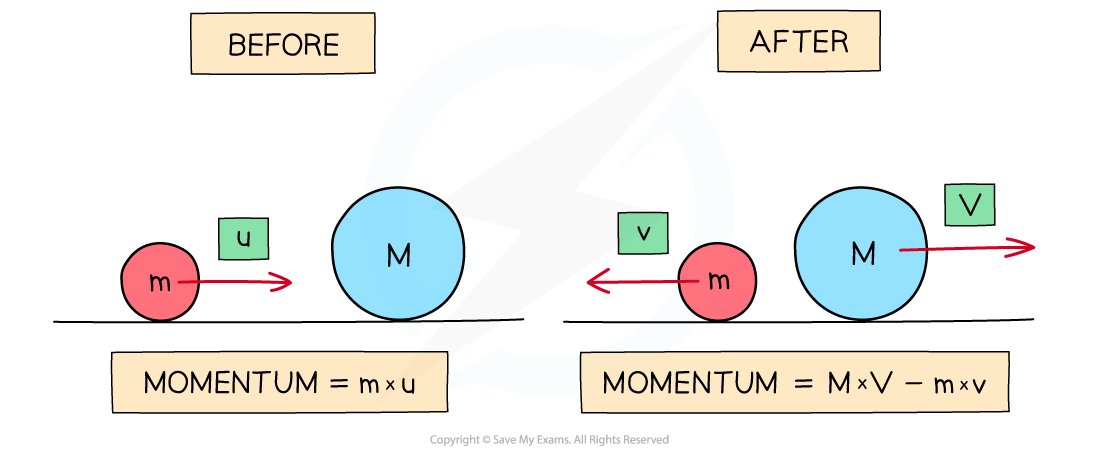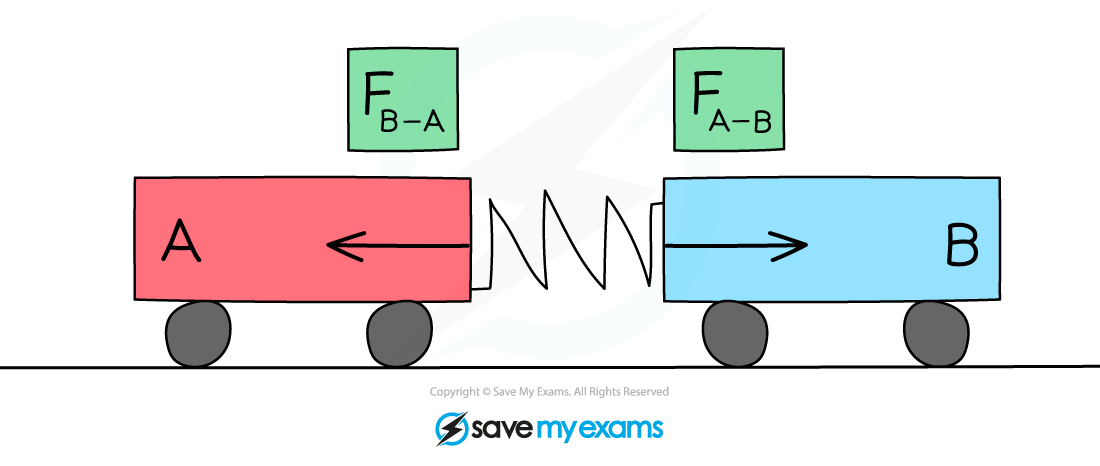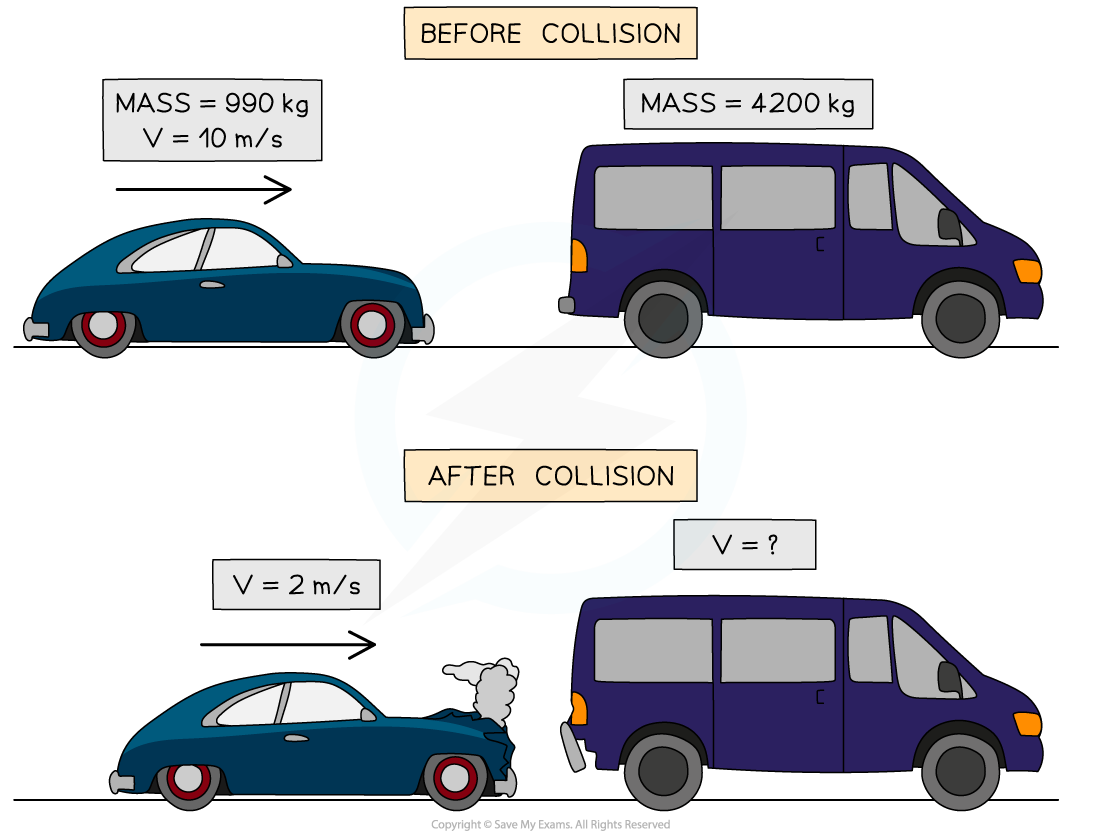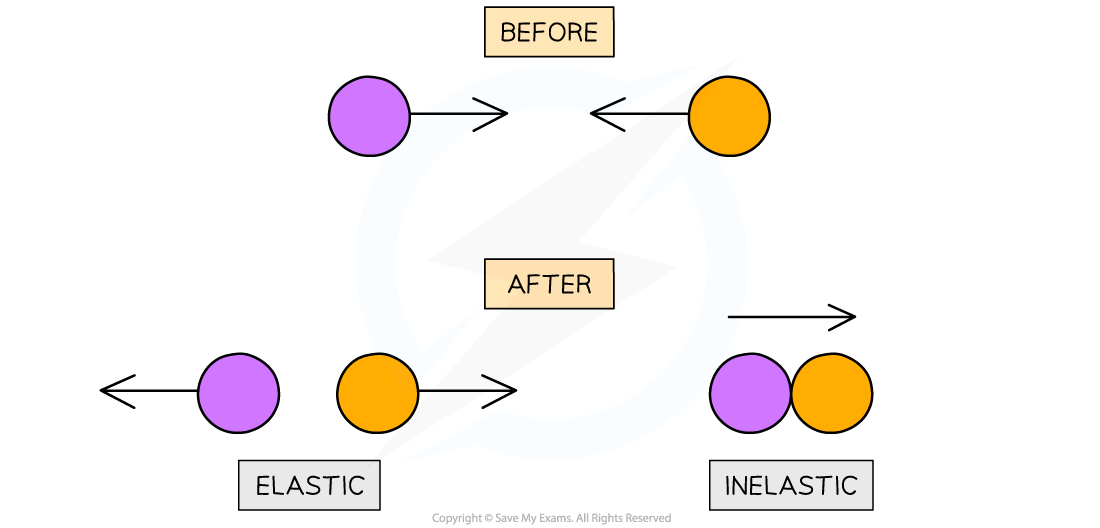Conservation of Momentum (WJEC GCSE Physics): Revision Note
Exam code: 3420
Conservation of Momentum
The principle of conservation of momentum states that:
The total momentum before an interaction is equal to the total momentum after an interaction, if no external forces are acting on the objects
In this context, an interaction can be either:
A collision i.e. where two objects collide with each other
An explosion i.e. where a stationary object explodes into two (or more) parts
Collisions
For a collision between two objects:
The total momentum before a collision = the total momentum after a collision
Before the collision:
The momentum is only generated by mass m because it is the only moving object
If the right is taken as the positive direction, the total momentum of the system is m × u
After the collision:
Mass M also now has momentum
The velocity of m is now -v (since it is now travelling to the left) and the velocity of M is V
The total momentum is now the momentum of M + the momentum of m
This is (M × V) + (m × -v) or (M × V) – (m × v) written more simply
Momentum Before and After a Collision

The momentum of a system before and after a collision where the momentum before equals the momentum after
Newton's Third Law in Collisions
According to Newton's Third Law:
When two objects collide, both objects will react, generally causing one object to speed up (gain momentum) and the other object to slow down (lose momentum)
Equal and Opposite Forces on Two Colliding Objects

Newton's third law can be applied to collisions. Here the force of trolley A on B is equal and opposite to the force of trolley B on A.
Consider the collision between two trolleys, A and B:
Trolley A exerts a force on trolley B
Trolley B exert an equal force on trolley A in the opposite direction
This can be written as:
Higher Tier Only
Explosions
Examples of explosions include:
A person jumping off a skateboard
A cannon or bullet being fired
A firework exploding
A person being thrown from a vehicle
The separation of space vehicles
As with collisions, the principle of conservation of momentum equations can be applied:
The mass of the separate objects = the mass of the original object
The initial velocity (and therefore, momentum) of the object is 0
Remember that velocity is a vector, so it considers the direction of the speed of each component
Some will travel in a positive direction and others in a negative direction
When they are all added together the resultant velocity = 0
Momentum of a Dynamite Explosion

The sum of the masses of the exploded pieces equals the mass of the original dynamite and the sum of the velocities of the separate pieces equals zero.
Worked Example
Higher Tier Only
The diagram shows a car and a van, just before and after the car collides with the van, which is initially at rest.
The car initially moves at a speed of 10 m/s, but this reduces to 2 m/s after the collision.

The mass of the car is 990 kg and the mass of the van is 4200 kg.
Calculate the velocity of the van when it is pushed forward by the collision.
Answer:
Step 1: State the principle of the conservation of momentum
Total momentum before a collision = total momentum after a collision
Step 2: Calculate the total momentum of the car and van before the collision
Momentum: p = mv
Initial momentum of the car:
pcar = 990 × 10 = 9900 kgm/s
Initial momentum of the van:
pvan = 0 (the van is at rest, so p = v = 0)
Total momentum before collision:
pbefore = pcar + pvan
pbefore = 9900 + 0 = 9900 kg m/s
Step 3: Calculate the total momentum of the car and van after the collision
Final momentum of the car:
pcar = 990 × 2 = 1980 kg m/s
Final momentum of the van:
pvan = 4200 × v
Total momentum after collision:
pafter = 1980 + 4200v
Step 4: Rearrange the conservation of momentum equation for the velocity of the van
pbefore = pafter
9900 = 1980 + 4200v
9900 − 1980 = 4200v
= 1.9 m/s
Worked Example
A gun of mass 3 kg fires a bullet of 30 g at a speed of 175 m/s.

As the bullet is fired, the gun moves back with a recoil speed v.
Calculate the recoil speed of the gun v.
Answer:
Step 1: List the known quantities:
Velocity of gun/bullet before firing = 0 m/s
Mass of gun, mgun = 3 kg
Mass of bullet, mbullet = 30 g = 0.03 kg
Velocity of bullet after firing , vbullet = 175 m/s
Velocity of gun after firing = v
Step 2: State the conservation of momentum equation
momentum before firing = momentum after firing
momentum before firing = velocity of gun/bullet before firing = 0
0 = (mgun × v) + (mbullet × vbullet)
Step 3: Substitute the known quantities into the equation
0 = (3 × v) + (0.03 × 175)
Step 4: Rearrange the equation to find the recoil speed of the gun
−3v = 5.25
v = −1.75 m/s
Therefore, the recoil speed of the gun is 1.75 m/s
Examiner Tips and Tricks
Remember any question with rearranging to obtain velocity is a higher-tier one.
If it is not given in the question already, drawing a diagram of before and after helps keep track of all the masses and velocities (and directions) in the conservation of momentum questions.
Remember that velocity is a speed with a direction. The question asks for the speed, so you do not need to include the final speed in your answer.
Momentum & Kinetic Energy
Higher Tier Only
In both collisions and explosions, momentum is always conserved
Energy is always conserved too, but kinetic energy might not always be conserved
A collision (or explosion) is either:
Elastic – if the kinetic energy is conserved
Inelastic – if the kinetic energy is not conserved
Collisions are instances when objects collide with each other:
Elastic collisions are usually when the colliding objects do not stick together and then they move in opposite directions
Inelastic collisions are usually when colliding objects stick together after the collision
Elastic and Inelastic Collisions

Elastic collisions are where two objects move in opposite directions. Inelastic collisions are where two objects stick together
To find out whether a collision is elastic or inelastic, compare the kinetic energy before and after the collision
The equation for kinetic energy is:
Where:
KE = kinetic energy (J)
m = mass (kg)
v = velocity (m/s)
Worked Example
Two similar spheres, each of mass m and velocity v are travelling towards each other. The spheres have a head-on elastic collision.

What is the total kinetic energy after the impact?
A.
B.
C.
D.
Answer: C
Step 1: Consider the meaning of an elastic collision
In an elastic collision, kinetic energy is conserved, so:
kinetic energy before = kinetic energy after
Step 2: Obtain an equation in terms of kinetic energy before and kinetic energy after
kinetic energy before =
So, kinetic energy after =
Worked Example
Trolley A of mass 0.80 kg collides head-on with stationary trolley B at a speed 3.0 m/s. Trolley B has twice the mass of trolley A. The trolleys stick together and travel at a velocity of 1.0 m/s.
Show that this is an inelastic collision.

Answer:
Step 1: State the known quantities
Mass of trolley A, MA = 0.80 kg
Mass of trolley B, MB = 2MA = 2 × 0.80 = 1.60 kg
Velocity of trolley A, VA = 3.0 m/s
Velocity of trolley B, VB = 1.0 m/s
Step 2: Recall the kinetic energy equation
Step 3: Calculate the kinetic energy before the collision
J
Step 4: Calculate the kinetic energy after the collision
J
Step 5: Interpret the calculations
Before the collision the total KE is 3.6 J, and after the collision the total KE is 1.2 J, so
Therefore, the collision is inelastic
Examiner Tips and Tricks
If an object is stationary or at rest, its initial velocity is 0, therefore, the momentum and kinetic energy are also equal to 0.
When a collision occurs in which two objects are stuck together, treat the final object as a single object with a mass equal to the sum of the masses of the two individual objects.
Despite velocity being a vector, kinetic energy is a scalar quantity and therefore will never include a minus sign - this is because in the kinetic energy formula, mass is scalar and the v2 will always give a positive value whether it's a negative or positive velocity.

Unlock more, it's free!
Did this page help you?